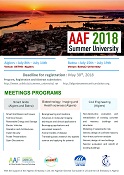You are here
Civil engineering and architecture
Design, Construction, Rehabilitation, and Resilience of the Built Environment
1-Program Coordinators:
- Amar Chaker, USA
- Abdeldjelil Belarbi, USA
- Fouad Bendimerad, USA
- Smail Haddadi, DZ
- Antonio Brancaccio, Italy
- Aomar Khaled, DZ
- Noureddine Bourahla, DZ
- Omar Khemici, USA
- Said Kenai, DZ
- Leila Hamroun, USA
2- Program Description:
Major advances have taken place in recent years in the design, construction and rehabilitation of the built environment, in the understanding of the hazards it is exposed to, and in the approaches for reducing disaster risk and for enhancing the resilience of the built environment, resilience being the ability to reduce the impact of catastrophes and to recover quickly after a disaster.
The advances to be presented and discussed are in the areas of materials, modeling, and analysis methods which may be used for buildings, bridges, and most infrastructure networks. They include the modeling of catastrophic risk, the non-destructive evaluation of existing structures, the use of composites for the rehabilitation of concrete structural elements and concrete and masonry structures, the design of confined masonry structures in seismic areas, the non-linear pushover analysis method for seismic analysis of structures, the seismic design of new buildings (e.g., ASCE 7-16), the methodology for the seismic evaluation and retrofit of existing buildings (ASCE/SEI 41-17), advances in techniques for the preservation of historic buildings and monuments, and techniques for evaluating and enhancing the resilience of interdependent infrastructure networks and communities.
This program is built to complement and support present or future developments in Algeria with an emphasis on the practical and research aspects. It is also essential to learn and develop new techniques and methodologies as they arise in the areas of civil engineering. The goal is to share, implement, adopt and adapt the new developments in the design, construction, retrofitting, and resilience of the built environment, and ultimately, to bring about changes in design, construction and risk management practices in Algeria.
3- Covered topics:
This program is broad and will cover basic concepts, advanced techniques and recent scientific
and technological advances in the field.
The main topics of the program will include:
• Non-destructive evaluation and rehabilitation of existing concrete and masonry buildings and structures
• Modeling of catastrophic risk
• Seismic design of confined masonry
• Non-linear pushover analysis
• Seismic design of new buildings
• Seismic evaluation and retrofit of existing buildings
• Preservation of historic buildings and monuments
• Resilience of interdependent infrastructure networks and communities
• Case studies
4- Desired Learning Outcomes:
Participants will be exposed to the latest technologies and learn theoretical and practical knowledge on diverse relevant aspects of the design, construction, rehabilitation and resilience of the built
environment. Instructors will guide and assist participants working in academia, research centres and engineering design and construction companies to develop their skills and will build a network of multiple actors in various fields in Algeria and abroad in order to build future collaborative projects.
5- Who Should Attend the Course?
Faculty, doctoral students, practicing engineers in the design and construction industry. Graduate students as well as post-doctoral researchers are welcome as well.
Submission:
Applicants must send the registration form with a short CV via the submission link:
https://easychair.org/conferences/?conf=aaf2018sum
AAF2018SUM-Instructions for Authors.pdf ![]()
- Be sure to choose only one course topic among :
Topic 1: Smart Grids in USTHB ;
Topic 2: Biology, biotechnology and health ;
Topic 3: Civil engineering and architecture ;
Topic 4: Smart Grids in Batna .
- Limited places - Candidates will be selected based on their curriculum.
By F.Djebarra

